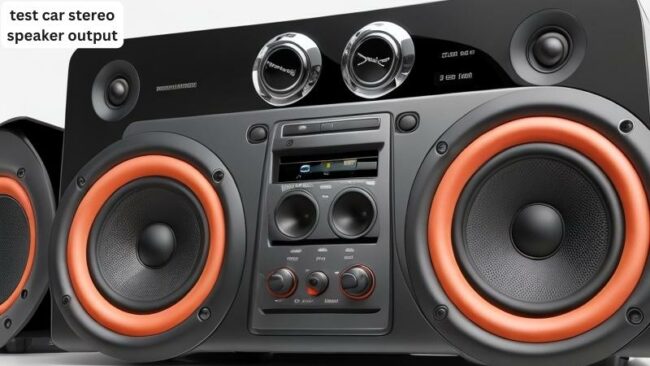how to test car stereo speaker output?
Today we discuss how to test car stereo speaker output. sometimes, you might notice that the sound quality ain’t what it used to be or suspect that something’s off with your speakers. Not to worry, though – we’ve got your back. We’re gonna walk you through how to test your car stereo speaker output, step-by-step. With these easy tricks, you’ll be able to spot any issues and fix them upright. So let’s get into it and make sure you’re getting the most outtalk of your ride’s audio system.
Prepare the Testing Equipment:
Before you begin testing your car stereo speaker output, gather the necessary equipment. You will need a few items, including a test tone generator, an audio amplifier, a digital multimeter, and speaker wire connectors. Ensure that the test tone generator can generate various frequencies to cover the full range of your speakers.
Connect the Test Equipment:
Start by connecting the test tone generator to the audio amplifier. Use speaker wire connectors to attach the amplifier’s output to the corresponding speaker wires in your car. Double-check the connections to ensure they are secure and free from any loose or frayed wires
Set the Test Tone Frequency:
Alright, so first things first, let’s get that test tone generator set up to make some noise at a frequency we can actually hear. Start with something in the middle, like 1 kHz, and then work your way up and down from there. Oh, and don’t forget to keep the volume in check – we don’t want to blow out those speakers by cranking them too high.
Measure Voltage Output:
Using a digital multimeter, set it to measure AC voltage. Connect the multimeter’s probes to the positive and negative terminals of the speaker wires connected to the amplifier. Play the test tone and observe the voltage reading on the multimeter. It should correspond to the expected voltage range for your speaker’s power output. Refer to your speaker’s specifications for the correct voltage range.
Listen for Sound Quality:
While measuring voltage provides a quantitative assessment, it’s equally important to evaluate the sound quality. Listen attentively to the test tone at different frequencies and note any distortions, buzzing, or muffled sounds. This step helps determine if there are any issues with the speaker’s performance or if further troubleshooting is required.
Listen for Sound Quality:
To ensure comprehensive testing, repeat the entire process for each speaker in your car audio system. It’s crucial to assess the output of each individual speaker to identify any specific problems that may exist.

faqs for how to test car stereo speaker output:
Answer:
While it might be technically possible, it’s not a recommended method for testing car stereo speakers.
Answer:
it is unnecessary and might not yield any meaningful results.
Answer:
Using a drone for this purpose is overcomplicating the process, and it won’t give you valuable insights.
Answer:
Installing speakers underwater is a bad idea and can damage both the speakers and your car’s electrical system
Answer:
testing multiple speakers at high volumes simultaneously could lead to distorted results and might damage the speakers.
Answer:
To test the car stereo speaker output, play a balanced audio track with a mix of highs, mids, and lows. Listen for any distortions, volume imbalances, or rattling sounds.
Answer:
Yes, you can use various audio sources like CDs, smartphones, USB drives, or streaming devices to test the speaker output. Make sure the audio files are of good quality and suitable for speaker testing.
Answer:
It’s recommended to test each speaker individually. This allows you to identify specific issues with a particular speaker, such as wiring problems or blown drivers.
Answer:
To access the speaker wires, you need to remove the car’s stereo head unit or consult the vehicle’s manual to locate the speaker wires’ connections.
Answer:
If you detect problems like distortion, low volume, or no sound from a speaker, you may need to check the wiring, replace blown speakers, or seek professional assistance from a car audio technician.
Final words:
Testing your car stereo speaker output is essential for maintaining optimal sound quality and identifying potential issues. By following the step-by-step guide outlined in this article, you can confidently assess the performance of your speakers. Remember to use the appropriate testing equipment, measure voltage output, and evaluate sound quality. Should you encounter any abnormalities or inconsistencies during the testing process, consult a professional car audio technician to diagnose and resolve the issues. Regularly testing your car stereo speakers will help ensure a pleasurable audio experience during your journeys on the road.





